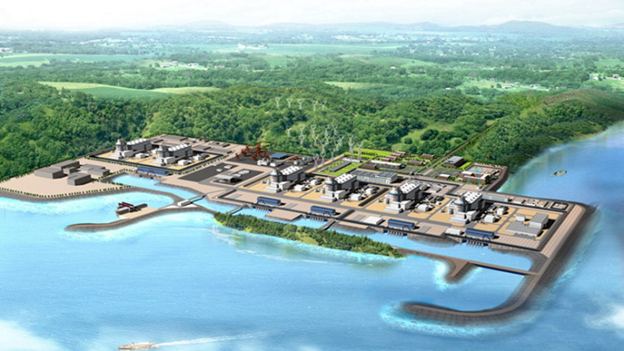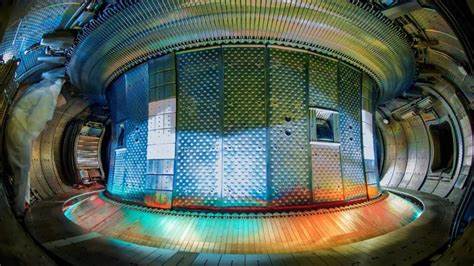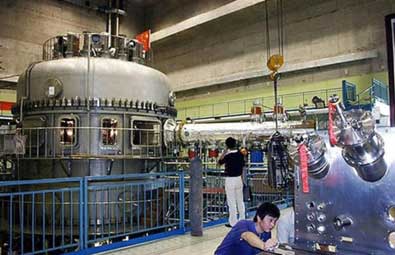China has begun the construction on its first nuclear reactor unit of the year with the pouring of first concrete at the Lufeng Nuclear Power Plant in Guangdong province. The milestone was completed on Monday. It marks the official start of the plant’s No. 1 reactor, which utilizes the CAP1000 third-generation pressurized water reactor (PWR) design. According to China General Nuclear Power Corporation (CGN), the CAP1000 design includes modular construction, digital building technologies, and automated welding to improve safety and efficiency.
As reported by China Daily, the plant will ultimately house six reactors, with Units 5 and 6 already under construction since 2022 and 2023, respectively. These last two units employ the Hualong One reactor which is based on China’s domestically designed third-generation nuclear technology.
When it is fully operational, the Lufeng nuclear power plant is expected to generate approximately fifty-two billion kilowatt-hours of electricity annually. This source of energy will help reduce China’s reliance on coal, saving an estimated sixteen million metric tons of standard coal per year. It will also cut carbon dioxide emissions by around forty-three million tons.
CGN emphasized that the Lufeng nuclear power plant project aligns with China’s commitment to reducing carbon emissions and will expand its clean energy infrastructure. CGN stated, “The official start of the main project of Unit 1 marks the full start of the construction of the dual third-generation nuclear power units of the Guangdong Lufeng Nuclear Power Project.”
The Lufeng nuclear power plant site was originally approved for four CAP1000 reactors by China’s National Development and Reform Commission in 2014. However, state approval for Units 1 and 2 was delayed until August 2023, while Units 3 and 4 are still waiting for final clearance.
The expansion of nuclear power in China is accelerating. The country approved the construction of ten nuclear power units annually over the past three years. with more nuclear power plants expected to break ground in the days ahead. By the end of 2025, China’s total installed nuclear capacity is estimated to reach sixty-five gigawatts, reinforcing its position as a world leader in nuclear energy development.
The CAP1000 reactor is a Chinese adaptation of the Westinghouse AP1000 reactor. It was developed by the Shanghai Nuclear Engineering Research and Design Institute. CAP1000 reactors feature passive safety systems and improved fuel efficiency, contributing to China’s strategy for sustainable nuclear power growth.
Meanwhile, Units 5 and 6 at the Lufeng nuclear power plant, which utilize the Hualong One reactor design, are scheduled for completion in 2026 and 2027. Hualong One is also known as HPR1000. It was developed jointly by CGN and China National Nuclear Corporation, further strengthening China’s independent nuclear technology capabilities.
The Lufeng project is one of several major nuclear initiatives currently underway in China. The Guangdong Lianjiang Nuclear Power Plant which began construction in July 2023, also features CAP1000 reactors, further reinforces the country’s commitment to nuclear energy expansion.
With ongoing investments in advanced nuclear technologies, China is securing its role as a leader in clean energy, reducing its reliance on fossil fuels, and meeting its carbon neutrality goals.
Blog
-

Nuclear Reactors 1482 – China Adds Two New Reactors To The Lufeng Nuclear Power Plant As It Expands Nuclear Power
-
Nuclear News Roundup Feb 26, 2025
Siemens Energy to supply turbines for Rolls-Royce SMR world-nuclear-news.org
UK’s SMR selection process ‘into final stage’ world-nuclear-news.org
Curtiss-Wright wins Natrium contracts world-nuclear-news.org
Russia says IAEA mission arrives at nuclear plant in Ukraine through Russia economictimes.indiantimes.com
-

Geiger Readings for Feb 26, 2025
Ambient office = 104 nanosieverts per hour
Ambient outside = 117 nanosieverts per hour
Soil exposed to rain water = 115 nanosieverts per hour
Tomato from Central Market = 104 nanosieverts per hour
Tap water = 144 nanosieverts per hour
Filter water = 134 nanosieverts per hour
-

Nuclear Fusion 114 – Chinese And French Fusion Research Reactors Achieve Record Plasma Confinement – Part 2 of 2 Parts
Part 2 of 2 Parts (Please read Part 1 first)
France has taken a major leap forward in the race for nuclear fusion energy. It just achieved a new world record for plasma duration. On February 12th, 2025, scientists at the French Alternative Energies and Atomic Energy Commission (CEA) successfully sustained a plasma reaction for one thousand three hundred and thirty-seven seconds (over twenty-two minutes) inside the WEST tokamak reactor.
This breakthrough surpasses the previous record of one thousand and sixty-six seconds (eighteen minutes), set by China’s EAST tokamak in January 2025, marking a 25% improvement. It demonstrates the growing ability to control fusion reactions for extended periods, a critical step toward making fusion energy a practical power source.
Located at the CEA Cadarache site in southern France, WEST (W Environment in Steady-state Tokamak) is an advanced research facility designed to explore the conditions necessary for sustainable fusion power.
During this experiment, the plasma inside WEST reached temperatures of ninety million degrees Fahrenheit, which is hot enough to sustain nuclear fusion. The team also confirmed that the reactor’s plasma-facing components remained stable. This proved that materials can withstand prolonged exposure to extreme heat and radiation.
Anne-Isabelle Etienvre is the Director of Fundamental Research at the CEA. She claimed that this milestone is a major technological step forward. She added, “WEST has achieved a new key technological milestone by maintaining hydrogen plasma for more than twenty minutes through the injection of two megawatts of heating power. WEST experiments will continue with increased power. This excellent result allows both WEST and the French community to lead the way for the future use of ITER.”
Nuclear fusion is frequently described as the “holy grail” of clean energy. Unlike nuclear fission, which powers today’s reactors by splitting atoms, fusion generates energy by fusing hydrogen isotopes, producing helium and enormous amounts of heat.
The potential benefits of commercial nuclear fusion are immense. Fusion power offers virtually limitless energy, as its most common fuel is derived from hydrogen, which is abundant and widely available. Unlike fossil fuels, fusion does not produce greenhouse gas emissions. This makes it an environmentally friendly solution for large-scale energy production. Unlike traditional nuclear fission, fusion creates minimal radioactive waste, as it does not generate long-lived radioactive byproducts.
The main challenge in generating fusion power on Earth has always been maintaining the plasma long enough for energy generation to be commercially viable. Plasma, the superheated gas where fusion reactions occur, must be confined within a powerful magnetic field inside a tokamak reactor. If the plasma becomes unstable, the reaction terminates.
The recent achievement at WEST brings scientists closer to solving this challenge, offering new hope that nuclear fusion can become a practical energy source in the near future.
WEST is part of an expanding international effort to develop nuclear fusion, alongside major projects like ITER, EAST, JT-60SA, and KSTAR. ITER, located in France, is the world’s biggest fusion experiment and is expected to begin operations in the 2030s. EAST, China’s Experimental Advanced Superconducting Tokamak, previously held the record for plasma duration as detailed above, but WEST’s latest breakthrough has now surpassed it.
In Japan, JT-60SA is testing new fusion reactor designs that could eventually be used in commercial fusion power plants. South Korea’s KSTAR project is also making advances in sustaining high-temperature plasmas for extended periods.
These projects are working together to develop the technologies needed for commercial fusion reactors. WEST’s latest findings are providing valuable data for ITER’s future operations. By proving that long-duration plasma reactions are achievable, WEST is helping to develop the engineering and materials that will be required for full-scale fusion power plants in the future.
While WEST itself will never become a commercial fusion power plant, its success lays the foundation for future reactors that could power entire cities with fusion energy. The next phase of research will focus on extending plasma durations even further. The goal is to eventually achieve multi-hour sustained reactions.
Increasing the heating power to achieve even higher temperatures, closer to two hundred million degrees Fahrenheit, will also be a priority. In addition, scientists will continue developing and testing new materials to ensure reactor components can withstand prolonged fusion conditions without degrading.
Despite these advances, commercial fusion power is still years away from large-scale deployment. Scientists must overcome critical challenges, including achieving net energy gain, meaning the fusion reactor must produce more energy than it consumes. Currently, no fusion reactor has successfully reached this milestone. However, WEST’s latest experiment brings that goal one step closer. -
Nuclear News Roundup Feb 25, 2025
IAEA Endorses Ghana’s Nuclear Site Selection In First-Ever Review Mission nucnet.org
Orano looks to positive 2025 despite events in Niger world-nuclear-news.org
Milestones for Canada’s Bruce Power units world-nuclear-news.org
North Korea Threatens US With Nuclear Response newsweek.com
-

Geiger Readings for Feb 25, 2025
Ambient office = 110 nanosieverts per hour
Ambient outside = 82 nanosieverts per hour
Soil exposed to rain water = 91 nanosieverts per hour
Red bell pepper from Central Market = 122 nanosieverts per hour
Tap water = 99 nanosieverts per hour
Filter water = 87 nanosieverts per hour
-

Nuclear Fusion 113 – Chinese And French Fusion Research Reactors Archive Record Plasma Confinement – Part 1 of 2 Parts
Part 1 of 2 Parts
China’s “artificial sun” reactor has broken its own world record for maintaining super-hot plasma. This marks another milestone in the long road towards near-limitless clean energy.
The Experimental Advanced Superconducting Tokamak (EAST) nuclear fusion reactor maintained a steady, highly confined loop of plasma for one thousand sixty-six seconds (eighteen minutes) on January 20th, 2025. This more than doubled its previous best of four hundred seconds. (seven minutes).
Nuclear fusion reactors are nicknamed “artificial suns” because they generate energy in a way that is similar to the Sun by fusing two light atoms into a single heavy atom via heat and pressure. The Sun has a lot more pressure than Earth’s fusion reactors, so scientists compensate by using temperatures that are many times hotter than the Sun
Nuclear fusion offers the potential of a huge power source without greenhouse gas emissions or much nuclear waste. However, scientists have been working on this technology for more than seventy years, and it is probably not progressing fast enough to be a practical solution to the climate crisis. Researchers expect us to have commercial fusion power plants within decades, but it could take much longer.
EAST’s new record won’t immediately usher in what is dubbed the “Holy Grail” of clean power. However, it is a step towards a possible future where commercial fusion power plants generate electricity.
EAST is a magnetic confinement reactor, or tokamak, which is designed to keep the plasma continuously burning for prolonged periods. Fusion reactors like this have never achieved ignition, which is the point at which nuclear fusion creates its own energy and sustains its own reaction. However, the new record is a step towards maintaining prolonged, confined plasma loops that future commercial fusion reactors will need to generate electricity.
Song Yunta is the Director of the Institute of Plasma Physics responsible for the fusion project at the Chinese Academy of Sciences. He said, “A fusion device must achieve stable operation at high efficiency for thousands of seconds to enable the self-sustaining circulation of plasma, which is critical for the continuous power generation of future fusion plants.”
EAST is one of a growing number of nuclear fusion reactors worldwide, but they all currently use far more energy than they produce. In 2022, the U.S. National Ignition Facility’s fusion reactor briefly achieved ignition in its core using a different experimental method to EAST. It relied on quick bursts of energy, but the reactor as a whole still used more energy than it consumed.
Tokamaks like EAST are the most common research nuclear fusion reactors. EAST heats up plasma and traps it inside a donut-shaped reactor chamber with powerful magnetic fields. For the latest Chinese EAST record, researchers made several upgrades to the reactor, including doubling the power of its heating system.
The data gathered by EAST will support the development of other fusion reactors, both in China and internationally. China is part of the International Thermonuclear Experimental Reactor (ITER) program. This project involves dozens of countries, including the U.S., U.K. Japan, South Korea and Russia.
The ITER reactor, which is being built in southern France, contains the world’s most powerful magnet and will be operational in 2039 at the earliest. ITER is an experimental tool designed to create sustained fusion for research purposes, but it could pave the way for commercial fusion power plants. Song said, “We hope to expand international collaboration via EAST and bring fusion energy into practical use for humanity.”Experimental Advanced Superconducting Tokamak
Please read Part 2 next
-
Nuclear News Roundup Feb 24, 2025
Wiernicki: New nuclear a generational opportunity for U.S. shipbuilding marinelog.com
German election results tilt EU back toward nuclear energy politico.eu
Construction starts on Lufeng unit 1 world-nuclear-news.org
WNA Chief Warns Spain’s Economic Future At Risk Without Nuclear nucnet.org
-

Geiger Readings for Feb 24, 2025
Ambient office = 105 nanosieverts per hour
Ambient outside = 98 nanosieverts per hour
Soil exposed to rain water = 101 nanosieverts per hour
Shallot from Central Market = 143 nanosieverts per hour
Tap water = 137 nanosieverts per hour
Filter water = 121 nanosieverts per hour
-
Nuclear News Roundup Feb 23, 2025
Global peace arrangements ‘unravelling’, UN chief warns nuclear disarmament conference scmp.com
Nuclear safety — Windsor residents get access to potassium iodide pills windsorstar.com
Governor Braun “hesitant” on rate payer burden for nuclear reactors tristatehomepage.com
NCRI-US Deputy Director: Regime Change is the Only Way to Stop Iran’s Nuclear Threat ncr-iran.org
